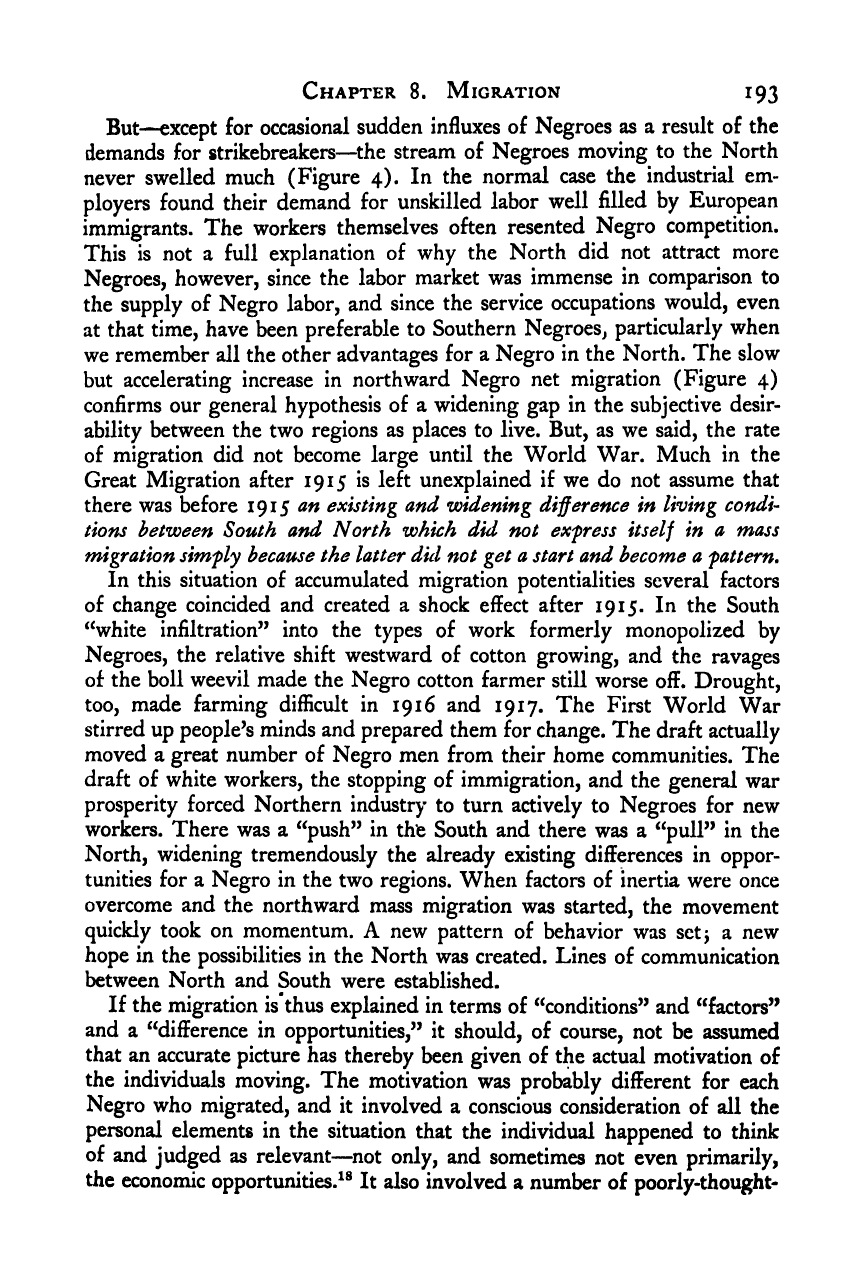Note: Gunnar Myrdal died in 1987, less than 70 years ago. Therefore, this work is protected by copyright, restricting your legal rights to reproduce it. However, you are welcome to view it on screen, as you do now. Read more about copyright.
Full resolution (TIFF) - On this page / på denna sida - III. Population and Migration - 8. Migration - 3. The Great Migration to the Urban North

<< prev. page << föreg. sida << >> nästa sida >> next page >>
Below is the raw OCR text
from the above scanned image.
Do you see an error? Proofread the page now!
Här nedan syns maskintolkade texten från faksimilbilden ovan.
Ser du något fel? Korrekturläs sidan nu!
This page has never been proofread. / Denna sida har aldrig korrekturlästs.
Chapter 8. Migration 193
But—except for occasional sudden influxes of Negroes as a result of the
demands for strikebreakers—^the stream of Negroes moving to the North
never swelled much (Figure 4). In the normal case the industrial em-
ployers found their demand for unskilled labor well filled by European
immigrants. The workers themselves often resented Negro competition.
This is not a full explanation of why the North did not attract more
Negroes, however, since the labor market was immense in comparison to
the supply of Negro labor, and since the service occupations would, even
at that time, have been preferable to Southern Negroes, particularly when
we remember all the other advantages for a Negro in the North. The slow
but accelerating increase in northward Negro net migration (Figure 4)
confirms our general hypothesis of a widening gap in the subjective desir-
ability between the two regions as places to live. But, as we said, the rate
of migration did not become large until the World War. Much in the
Great Migration after 1915 is left unexplained if we do not assume that
there was before 1915 an existing and widening difference in living condi-
tions between South and North which did not exfress itself in a mass
migration simfly because the latter did not get a start and become a fattern.
In this situation of accumulated migration potentialities several factors
of change coincided and created a shock effect after 1915. In the South
‘‘white infiltration” into the types of work formerly monopolized by
Negroes, the relative shift westward of cotton growing, and the ravages
of the boll weevil made the Negro cotton farmer still worse off. Drought,
too, made farming difficult in 1916 and 1917. The First World War
stirred up people’s minds and prepared them for change. The draft actually
moved a great number of Negro men from their home communities. The
draft of white workers, the stopping of immigration, and the general war
prosperity forced Northern industry to turn actively to Negroes for new
workers. There was a “push” in the South and there was a “pull” in the
North, widening tremendously the already existing differences in oppor-
tunities for a Negro in the two regions. When factors of inertia were once
overcome and the northward mass migration was started, the movement
quickly took on momentum. A new pattern of behavior was setj a new
hope in the possibilities in the North was created. Lines of communication
between North and South were established.
If the migration is thus explained in terms of “conditions” and “factors”
and a “difference in opportunities,” it should, of course, not be assumed
that an accurate picture has thereby been given of the actual motivation of
the individuals moving. The motivation was probably different for each
Negro who migrated, and it involved a conscious consideration of all the
personal elements in the situation that the individual happened to think
of and judged as relevant—^not only, and sometimes not even primarily,
the economic opportunities.^® It also involved a number of poorly-thought-
<< prev. page << föreg. sida << >> nästa sida >> next page >>